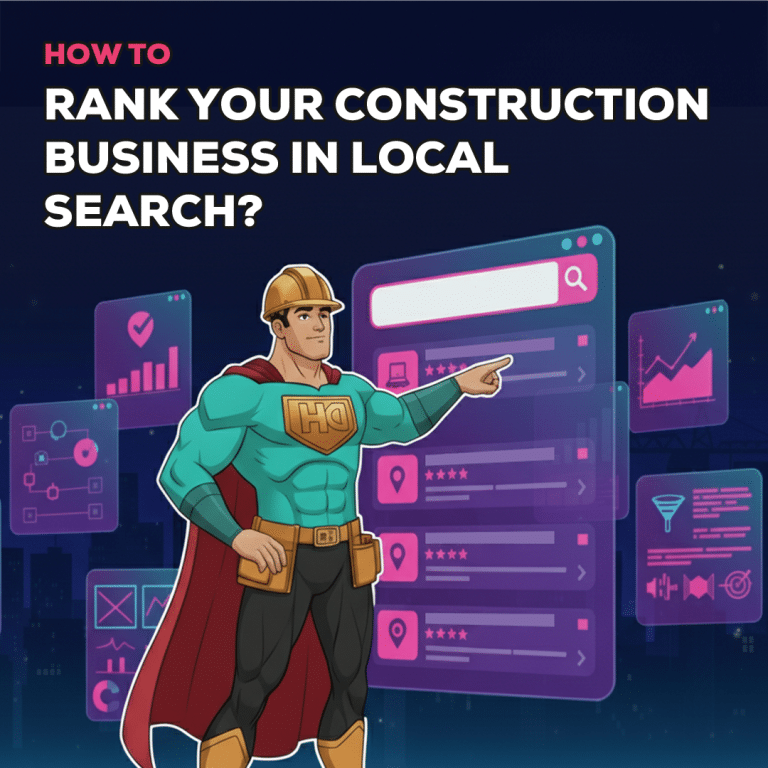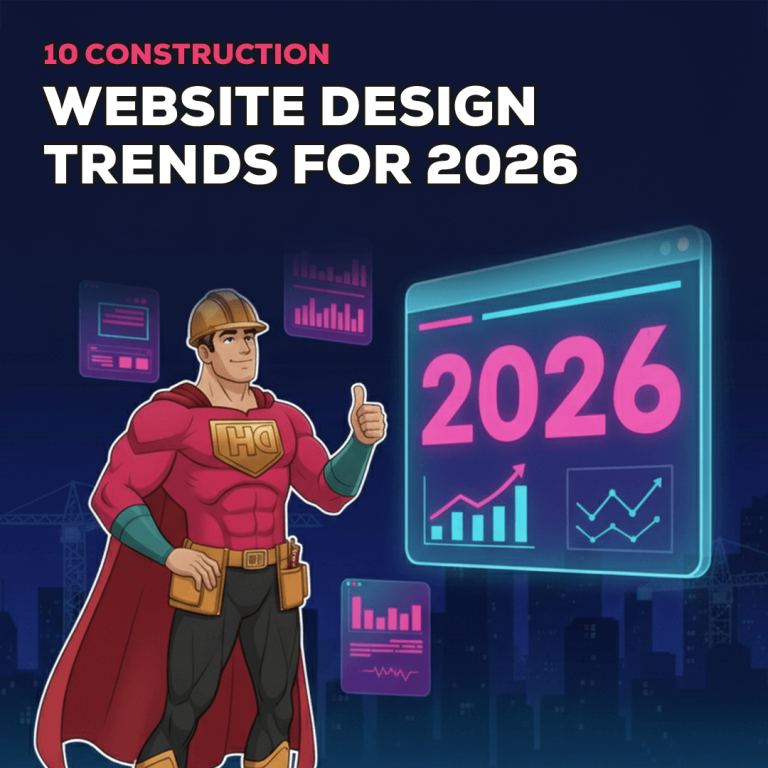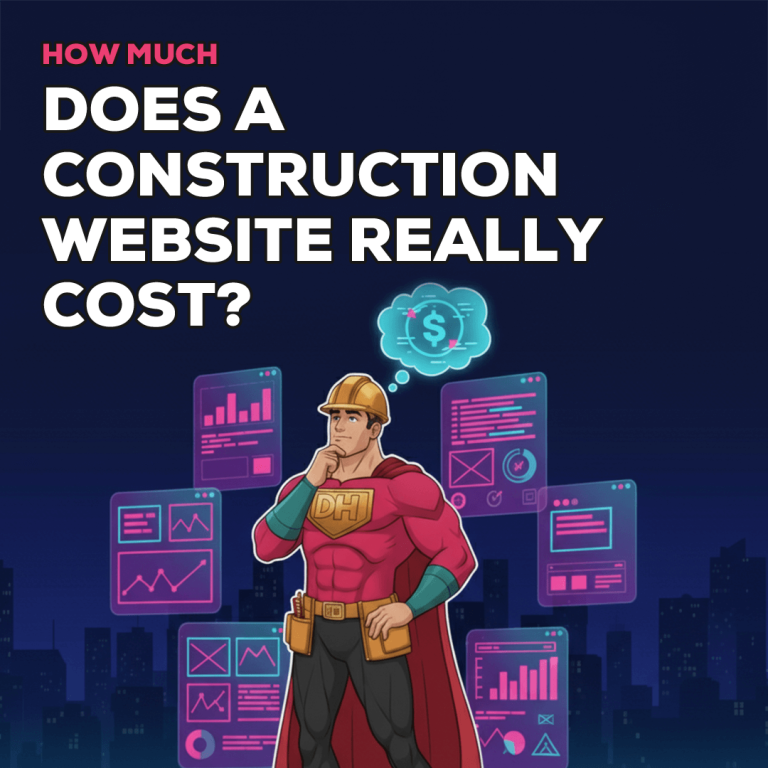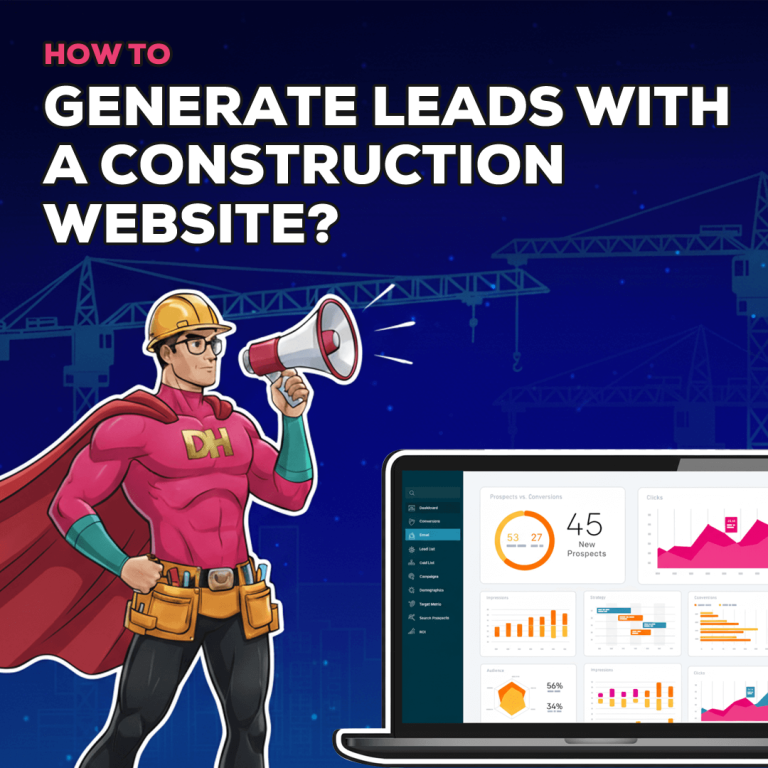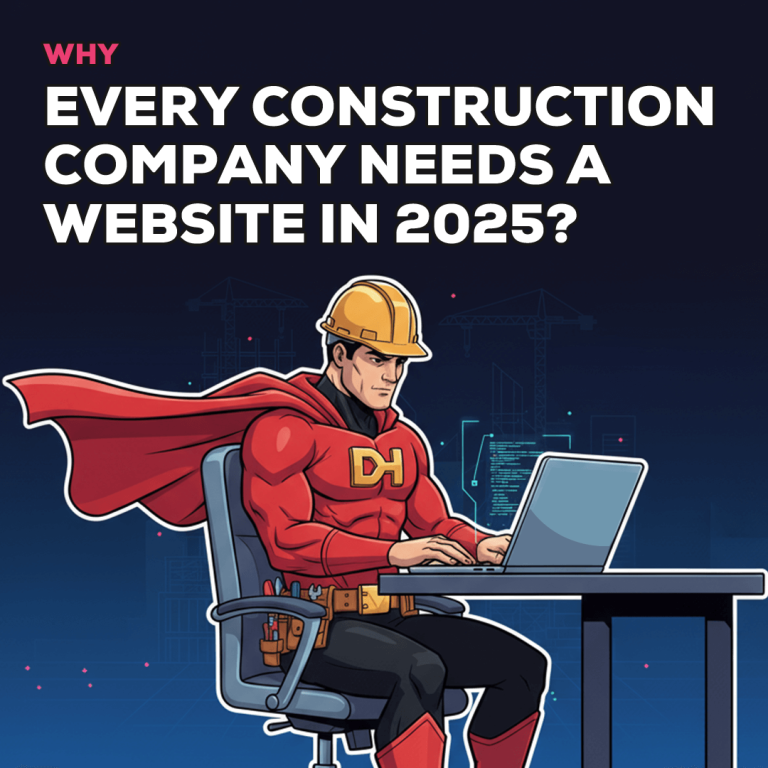A good website could make the difference between success and failure for your construction business. Without one, you might miss up to 80% of your possible projects.
The numbers tell an impressive story. Companies that invest in a well-designed website see their revenue grow by 25% on average in the first year alone. My years of experience building websites for construction companies have taught me something valuable. A successful construction website does more than look impressive – it brings new clients and builds your company’s reputation.
The construction market is changing rapidly. Higher mortgage rates have pushed many homeowners to renovate their existing homes rather than buy new ones. Construction companies now need websites that attract clients, establish trust, and secure more projects. The numbers don’t lie – 94.1% of people worldwide browse the internet on their phones. This makes a mobile-friendly website vital for construction companies today.
Let me share 10 valuable Lessons for Building Successful Construction Company Websites in this piece. These insights have helped my clients build professional websites that turn visitors into customers.
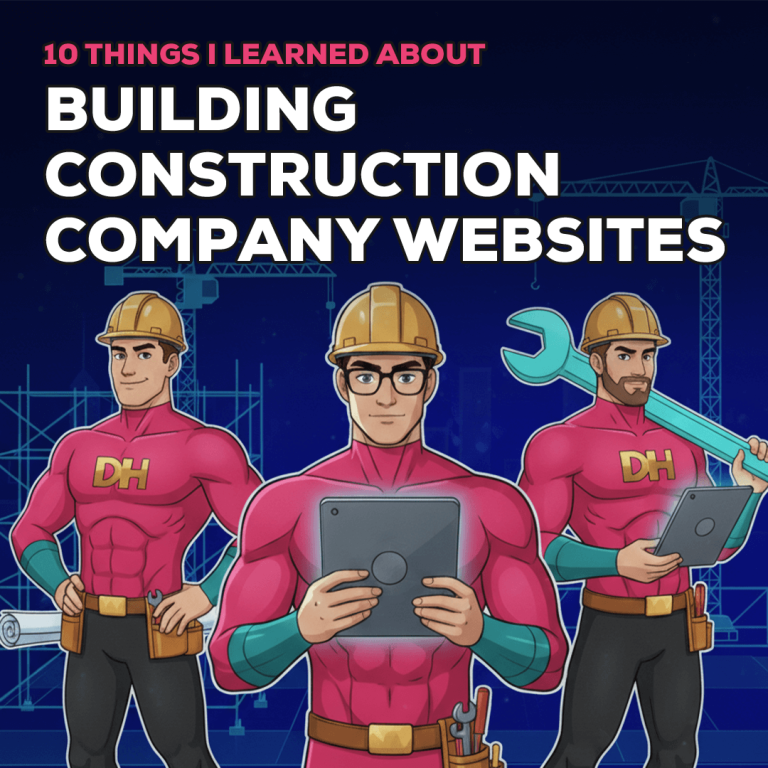
10 things I learned about building construction company websites
Clear Value Proposition is Non-Negotiable
Clients make snap judgments about construction websites in mere seconds. My experience shows their first question isn’t about your beautiful design it’s “Why should I choose this company over others?” A clear value proposition makes all the difference here.
A unique value proposition (UVP) sets your construction company apart from competitors. This concise statement tells visitors why your services stand out from the rest. Your UVP serves as the cornerstone of your construction company website, not just a marketing tactic.
My work with dozens of construction websites reveals a pattern: companies with strong value propositions win more bids consistently. A compelling UVP can determine whether you win or lose projects to competitors. Your construction website should display this value proposition prominently on the homepage where visitors see it immediately.
Your UVP must tackle specific client problems head-on. Take this example: if you specialize in eco-friendly building practices, your value proposition might showcase your steadfast dedication to green materials and energy-efficient designs. This resonates with environmentally-conscious clients who seek these specific benefits.
The most successful construction websites go beyond listing services they demonstrate client impact. Research shows that 90% of customers stay loyal to companies they believe understand their needs. Your website needs to show how your services create better outcomes for clients clearly.
Your value proposition should blend these elements:
- The specific problems you solve for clients
- Your unique strengths and differentiators
- Tangible benefits clients receive when choosing you
This value proposition should pervade your entire organization. The promise you make on your construction website demands delivery throughout your company. One expert puts it simply: “Failure to deliver on the UVP is not an option for anyone in your company”.
Keep your value proposition sharp and focused. Use minimal words while maintaining clarity. Your construction website should feature this UVP in headlines with supporting visuals that strengthen your message.
Ready to create a construction website with a clear value proposition? Contact Design Hero today.
Strong Visuals Build Trust
Visual elements on your construction website act as a digital handshake between you and potential clients. A Stanford University study revealed that 75% of users judge a company’s credibility based solely on website design. These numbers show why strong visuals do more than decorate they build trust.
Professional photography makes an instant impression of quality and precision. High-resolution images of your completed projects tell potential clients about your attention to detail. Websites with complete portfolios get 47% more asks than those without. This significant gap shows how visual content turns into real business opportunities.
“What you are going for is trust,” industry experts point out. Professional, high-resolution photos prove you’re detail-oriented throughout your business. These photos represent your craftsmanship when you can’t be there in person.
Your website needs these visuals to build trust:
Before-and-after galleries: These powerful comparisons help potential clients see transformations and picture possibilities for their own projects
Team photos: Research shows clients trust real faces; authentic team images build instant credibility and make your business more approachable
Project portfolios: Detailed case studies with professional photographs prove your expertise and show your authority in the industry
Virtual tours: These show transparency and professionalism by letting clients explore completed projects
Visual content gets 94% more views than text-only content. Construction companies that use high-quality images leave lasting impressions and show their work’s true scope and quality.
Videos (30 seconds to 2 minutes) add depth to your visual storytelling. Short videos highlight details and show your process, which creates excitement about working with your company. Drone footage, client interviews, and progress videos build extra credibility and showcase your expertise from different angles.
Note that visual branding goes beyond project photos. A consistent color palette helps clients recognize your brand quickly. Blue often signals reliability and trust perfect qualities for construction companies.
Building credibility through transparency remains the main goal. Clients feel confident in your abilities when they see quality work through professional visuals. With 88% of consumers trusting online reviews and portfolios as much as personal recommendations, a strong visual presence becomes crucial for construction companies that want to establish trust before meeting clients.
Mobile Responsiveness is a Must
Mobile optimization has become crucial for business success, as my experience building websites for construction firms clearly shows.
The numbers tell a compelling story. Mobile devices now drive over half of all global web traffic, and some sources push this number up to 60%. Your construction website’s flawless performance on smartphones and tablets has become non-negotiable due to this fundamental change in browsing habits.
Construction companies face an even greater need because clients and team members often access websites right from job sites. A website that lacks mobile-friendliness could cost you more than half your visitors before they see your work portfolio.
Bad mobile optimization hits hard and fast. Research reveals that 53% of mobile users leave websites loading slower than three seconds. The stakes are higher as 94% of users distrust companies with poorly designed websites. These statistics point to missed business opportunities.
A well-optimized construction website needs:
Responsive design – Your site should automatically adjust to fit any screen size, keeping text readable and images properly sized
Fast loading times – Compressed images and optimized code matter most for image-heavy construction portfolios
Touch-friendly navigation – Buttons and links need enough size to tap easily without zooming
Simplified menus – The standard “hamburger menu” (three horizontal lines) serves mobile devices well
Click-to-call functionality – Tappable phone numbers let potential clients reach you with one touch
Google’s mobile-first indexing now assesses your website’s mobile version as the primary factor in search rankings. This makes mobile optimization vital for visibility, especially for construction firms that depend on local searches.
Mobile-friendliness testing doesn’t need to be complex. Google’s mobile-friendly testing tool offers an objective assessment. You should also test your site on different mobile devices to see what clients experience.
Proper mobile optimization brings rewards beyond better user experience. Construction websites with mobile-responsive design see higher conversion rates, longer site visits, and more project requests.
Mobile users browse differently than desktop users. They scan content quickly and want immediate information access. Your construction website should match these priorities through concise content, clear calls-to-action, and optimized design elements.
Simple Navigation Wins Every Time
A successful construction website needs solid navigation at its core. My experience in developing websites for builders and contractors has shown that simple navigation works better than complex menu systems. Users typically abandon websites in 10-20 seconds when they can’t find what they need.
Your construction website’s architecture should reflect the same simplicity and structural integrity as your building projects. Most visitors to construction websites look for specific details: services, past projects, and contact information. Making these elements readily available boosts user involvement.
My research shows construction websites with clear, easy-to-use navigation have 50% lower bounce rates compared to sites with complex menus. Your navigation serves as a roadmap clients will turn to your competitors if they can’t follow it easily.
The main navigation should have 5-7 items maximum to get the best results. Research shows visitors often make no choice when faced with too many options a phenomenon called “choice paralysis.” This indecision results in missed opportunities and fewer conversions.
Construction websites work best with this navigation structure:
- Home
- Services/What We Do
- Projects/Portfolio
- About Us
- Testimonials
- Blog/Resources
- Contact
A “sticky” navigation bar that stays visible as users scroll down the page can improve user experience by a lot. Users never lose their way on your site with this feature.
Your navigation should stay consistent throughout the website. Menu locations or structures that change between pages create confusion and frustration emotions you don’t want linked to your construction brand.
The hamburger menu (three horizontal lines) suits mobile devices well but desktop versions should show the full menu when space allows. This difference ensures the best user experience on all devices.
The goal is to create a navigation system that becomes invisible clients find what they need without thinking about the process.
Note that your website navigation shows how you handle project management. A confusing, disorganized menu suggests chaos in construction projects. Simple, logical navigation builds confidence in your organizational skills and attention to detail before clients meet you in person.
Testimonials and Case Studies Add Credibility
Seeing proof of your past success convinces potential clients better than anything else. Client testimonials and case studies work as powerful social proof that turn skeptical website visitors into confident leads.
Your marketing messages become more persuasive with testimonials that act as authentic, relatable content. This authenticity matters because potential clients look at others’ experiences to judge a company’s service quality and reliability. Client testimonials can significantly influence how people choose their construction company.
Construction websites need testimonials to provide social proof that reduces hesitation and drives action. This works especially when you have high-stakes industries like construction, where trust becomes crucial before big project investments. Your credibility with future customers grows through client feedback that serves as a powerful marketing tool.
Case studies elevate testimonials by offering detailed examples of your work. You get to share your best client experiences and prove your expertise with solid evidence.
Here’s how to create effective case studies:
- Write a brief summary of your customer’s problem or task
- Explain the strategies you used and show measurable results
- Add visuals like before-and-after photos or infographics
- Share this valuable content on all your digital platforms
Your construction website’s testimonial placement matters as much as the content itself. Testimonial sliders, banners, or dedicated review pages make them more visible and impactful. This approach boosts your online presence and ended up building more trust with potential customers.
Detailed testimonials prove your credibility by showing you keep your promises. Your marketplace authority grows when clients put their name or brand on your work, making you the safe, trusted choice. The best testimonials include specific results, relatable details about your client’s situation, and natural language instead of marketing jargon.
Good testimonials sound like real conversations that honestly share both challenges and results. They turn doubt into trust, making them your construction website’s most valuable tools. Note that well-crafted testimonials help your company stand out in a busy construction market.
Local SEO Drives the Right Traffic
Local search engine optimization isn’t just a marketing buzzword it makes the difference between your ideal customers finding you or missing you completely in your service area. My work on construction websites has shown me how proper local SEO turns online visibility into real project leads.
Local SEO helps your construction website rank higher when potential customers in your area look for contractors. Your online presence matters more than you might think 96% of people learn about local businesses online. Searches including “near me” now make up 46% of all Google searches.
Local SEO brings in visitors who are ready to buy. These people searching for construction services in their area usually have their wallets out. One industry expert puts it well: “If you take one thing away from this guide, let it be the importance of reviews“. Reviews serve double duty as marketing tools and ranking factors.
Here’s an eye-opening fact: 87% of people searching for construction services reach out to just one company. Your spot at the top of local search results could mean landing or losing potential clients.
Construction companies need these key elements for effective local SEO:
- Google Business Profile optimization – 64% of buyers use GBP to find businesses’ contact information
- Consistent NAP information (Name, Address, Phone) across all online platforms
- Location-specific landing pages highlighting services in particular neighborhoods
- Local keywords with geo-modifiers in titles, content, and metadata
- Regular client reviews – 72% of people rely on Google reviews when finding companies
- Numbers tell the story: Google handles 5 trillion searches in 2024, with 1.7 million monthly searches just for contractors. Local SEO offers a huge chance for growth. A website alone won’t cut it it needs optimization for local search intent.
Strong local SEO builds your brand’s reputation until you become the first choice for construction in your area. More appearances in local search results lead to increased trust and recognition from potential customers.
Construction companies that focus on local SEO see faster sales cycles, better client matches, and stronger community presence. Most contractor-specific searches now come from mobile devices, making local SEO a vital part of any growth strategy.
Fast Load Speed Retains Visitors
Page loading speed makes or breaks your construction website’s success. Your potential clients expect pages to load within 2-3 seconds. They’ll leave your site quickly after that critical point.
Speed directly affects your revenue. Websites that load in one second achieve 3.05% conversion rates. This drops sharply to 1.08% for sites taking five seconds. Slower construction websites generate three times fewer leads.
These stats tell the real story:
- Your bounce rates jump 32% if pages take 3 seconds instead of 1 second to load
- B2B construction sites loading in 1 second convert 3 times better than 5-second loads
- Mobile page delays cost you 20% fewer conversions per second
- BBC saw 10% of users leave with each extra second of loading time
Construction companies feel these numbers in missed opportunities. Your project gallery’s slow loading could cost you one in ten potential clients. This hurts both your brand and your bottom line.
Your portfolio and testimonials might look amazing, but 47% of people want sites to load within 2 seconds. Another 40% leave if pages take more than 3 seconds. This matters even more in construction, where project photos and videos help sell your services.
Making your construction website faster needs some tech know-how. Images often slow things down because they’re bigger than HTML and CSS files. You need to size and compress project photos smartly without losing quality.
Smart construction businesses use Google’s Page Speed tool to check their website performance. This gives you a clear score and practical tips to improve.
Better speed brings real results. AutoAnything boosted sales by 12-13% by cutting their load times in half. Your construction website’s speed determines if visitors stick around long enough to become clients or jump to your competitors.
Calls-to-Action Should Be Everywhere
Calls-to-action (CTAs) that work are the foundation of any construction website’s conversion strategy. My experience shows that placing CTAs across your site not just on the homepage or contact page boosts lead generation by a lot.
Construction CTAs have their own special role. You won’t close a sale right away you’ll start a conversation. A weak CTA comes across as: “We’re here… somewhere… maybe call us?” A strong one clearly says: “We understand your concerns. Here’s exactly how to take the next step risk-free, no pressure”.
People browsing your website need a prompt to take action. This simple fact explains why construction sites with well-laid-out CTAs perform better than those without them.
These high-visibility spots work best for CTAs:
- Above the fold (visible without scrolling)
- After each project case study or portfolio item
- Midway through service pages
- In sticky headers for mobile users
- At the bottom of every service page
Your CTA type should match different buyer stages. Not everyone wants to “Request a Quote” right away. Early-stage prospects might prefer “Book a Free Site Visit” while researchers appreciate “Download Our Construction Planning Checklist“.
Words in your CTA make a huge difference. Clear action phrases with reassurance work better than vague ones: “Get a Custom Quote – No Obligations” or “Talk to a Builder – No Sales Pressure“. These phrases help visitors act without worry.
Each page should focus on one clear goal instead of several unclear ones. A single strong action beats multiple confusing options. Too many CTAs can overwhelm visitors who might end up choosing none.
Testing different CTA versions is crucial. Small tweaks changing “Request a Quote” to “Book Your Free Estimate” can boost form submissions by a lot. Local construction companies should try area-specific CTAs like “Looking to build in Austin? Talk to our team on-site”.
Content Marketing Positions You as an Expert
You earn expert status through consistent, valuable content on your construction website. Content marketing changes your digital presence from a basic portfolio into a trusted resource for prospective clients.
Your construction website can work harder with a strategic content marketing approach that establishes your industry authority. Sharing insights and participating with others positions you as a credible authority in construction. This helps your business thrive and creates a competitive advantage.
Your construction website should have:
- Blog posts that address common questions and industry challenges, such as “How to
- Choose the Right Contractor” or “Tips for Successful Home Renovations”
- Project case studies with detailed descriptions, high-quality images, and customer testimonials that showcase your expertise
- Video content such as tutorials, project walkthroughs, and time-lapse builds that connect with audiences while building authority
- Authority articles showing your unique view on industry challenges and opportunities
A content marketing strategy on your construction website will help establish your industry authority. Quality content production guides more qualified leads as potential clients follow your insights.
Benefits go beyond immediate leads. Your construction website becomes a platform to show expertise in safety regulations and legislative changes. This builds trust and confidence in your daily work. This approach helps you avoid looking too sales-focused. People recognize your industry dedication when you share helpful content freely.
LinkedIn is a great platform for construction professionals to share insights, discuss innovative solutions, and provide valuable knowledge. The person who’s “in-the-know” ended up increasing brand awareness, stabilizing customer retention, and attracting new clients.
Note that establishing expertise through content needs long-term commitment. The rewards come as you build relationships that create business opportunities. Content marketing remains one of the best inbound marketing tools to help construction companies distinguish themselves.
Security and Professionalism Go Hand-in-Hand
Website security isn’t just a technical necessity it shows your construction business’s professionalism and shapes how potential clients see your company. A secure website proves you take everything in your business seriously, including client information management.
HTTPS encryption (the padlock icon in browsers) builds instant credibility. This visual indicator tells visitors their information stays protected when they submit contact forms or request quotes. Modern browsers flag non-HTTPS sites as “Not Secure,” which creates immediate distrust among potential clients.
Your commitment to high standards throughout business operations shines through regular security updates. You wouldn’t leave a construction site vulnerable, and your digital presence needs the same protection and maintenance.
Conclusion
A construction company’s website needs more than just good looks to work well. My years of experience with construction businesses have taught me valuable lessons that I want to share. A well-crafted website acts as your round-the-clock digital ambassador and works to attract qualified leads while building credibility.
Successful construction websites share some simple elements. They need clear value propositions, professional visuals, mobile responsiveness, and user-friendly navigation. Strong testimonials, strategic CTAs, and fast loading speeds can boost your conversion rates significantly.
Local SEO remains the key element for construction companies looking for nearby clients. The right strategies will put your business at the top of search results when potential customers need you most. Content marketing helps establish your expertise, while security features demonstrate your professionalism and build trust.
Your construction website does more than showcase your work it’s a powerful tool that stimulates your company’s growth. Design Hero can help you put these strategies into action. Reach out!
The digital world changes faster every day. Your website needs regular reviews and updates to perform its best. These improvements might seem daunting at first, but each step brings you closer to a website that delivers real results. Start with the fundamentals and build your online presence step by step. Your future clients search online right now they should find you before your competition.
Key Takeaways
Building an effective construction company website requires strategic focus on elements that directly impact lead generation and credibility.
Mobile optimization is critical – With 56.75% of website traffic coming from mobile devices, responsive design ensures you capture leads from job sites and on-the-go clients.
Visual content builds instant trust – High-quality project photos and before-and-after galleries receive 94% more views than text, directly translating to more inquiries.
Local SEO drives qualified traffic – 96% of people research local businesses online, making location-based optimization essential for attracting nearby clients.
Fast loading speeds retain visitors – Pages taking longer than 3 seconds lose 53% of visitors, making speed optimization crucial for image-heavy construction portfolios.
Strategic calls-to-action increase conversions – Well-placed CTAs throughout your site guide visitors from interest to action, with specific phrases like “Book Your Free Estimate” outperforming generic requests.
A professional construction website isn’t just an online brochure it’s a 24/7 lead generation tool that can increase revenue by 25% in the first year when properly optimized with clear value propositions, testimonials, and security features.

FAQ
Why does a construction company need a website?
A website acts as your digital storefront, helping potential clients find you, view your projects, and contact you easily.
How can I make my construction website stand out?
Showcase high-quality visuals of past projects, include testimonials, keep the design professional, and make it easy to request quotes.
What’s the most important feature of a construction company website?
Clear contact options and calls-to-action like a phone number, consultation form, or request-a-quote button are the most crucial for converting visitors into leads.
About the author

Nicholas Robb, Founder
The original Design Hero founder, solopreneur and marketing expert; Nick will help you supercharge your business success with a broad skill-set spanning a range of digital marketing fields.
If you want help growing your business

